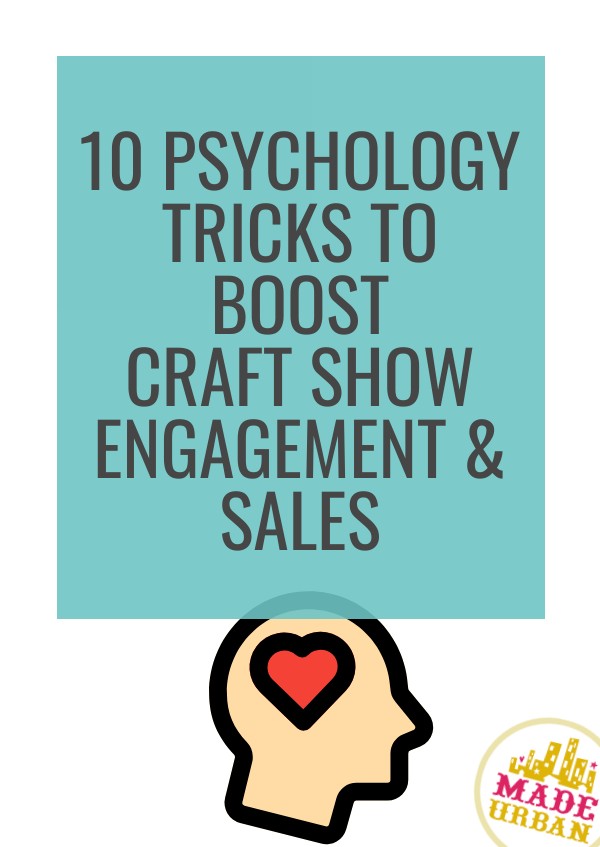10 Psychology Tricks To Boost Craft Show Engagement & Sales
Craft show shoppers enter with open minds, but can easily feel overwhelmed from aisle after aisle of beautiful handmade goods.
That means the way you present your products—and the psychological cues you use—can significantly influence whether someone stops, engages, and ultimately makes a purchase.
Below are ten powerful, ethical psychology tricks craft show vendors can apply to attract attention, keep shoppers browsing longer, and make purchasing feel natural and enjoyable.

1. Capture Attention in Under 3 Seconds
Craft show aisles move fast. Shoppers make snap judgments based on the look and feel of your booth and even the colors of your products.
Psychology at work: The brain is wired to spot “visual hierarchy”. You can use this by creating one bold “anchor point” shoppers notice instantly—like a large hero product (here’s how to create one), a tall display piece, or bold blocks of color (how to create color groupings).
Tip: Before the show opens, walk the aisle and look at your booth from 10 feet away. Ask yourself:
Is anything visually pulling me in?
2. Use “Cognitive Ease” to Make Decisions Feel Effortless
When shoppers feel confused, overwhelmed, or uncertain, they walk away.
Reduce mental effort by:
- Clear, legible signage – Point out the benefits customers care about.
- Grouping like with like – Displaying knitted stuffed toys with knitted scarves creates confusion. Displaying knitted scarves with knitted hats and mittens makes it easy for shoppers to think about winter accessories.
- Showing photos of product use – Help shoppers imagine how they’ll wear/use/display your products.
Psychology at work: The brain prefers paths of least resistance. When shopping feels easy, people are more likely to keep browsing—and buying.
3. Apply the “Endowment Effect” with Touchable Displays
People value objects more when they feel like it’s “theirs”. And when shoppers touch and interact with your products, they’re closer to feeling an attachment to them.
Encourage tactile engagement:
- Place products within reach
- Add “Please Pick Me Up” signs
- Use mirrors, testers, or samples
- Demo products throughout the day
Why it works: Touch builds emotional connection and increases perceived ownership, which boosts the likelihood of purchase.
4. Build Trust Fast
In craft show settings, trust is built in seconds.
Use small but powerful behaviours:
- Make eye contact as they step into your booth
- Give a warm, pressure-free greeting
- Comment on something specific (“I love your scarf—such a great color!”)
- Allow them to browse with no pressure
This article shares more ways to build trust quickly: The Key to Faster Craft Show Sales: Build Trust with Shoppers
Psychology at work: People are more likely to buy from someone who feels approachable.
5. Reduce Overwhelm
Craft show booths can accidentally create choice paralysis; too many options, too many variations, too much visual noise. Here’s How to Tell if your Craft Business Has Too Many Products
Help your customer’s brain by:
- Offering curated bundles
- Showing “bestsellers” or “most popular” items
- Creating small, digestible displays instead of one big one
Why it works: When shoppers feel guided rather than overloaded, they’re more likely to commit.
6. Create “Mini Movie Scenes”
Instead of showing a sea of products, display small scenes that show how items fit into everyday life.
For example:
- A cozy reading nook feel for blankets or candles
- A mini vanity setup for jewelry
- A festive table layout for holiday décor
Psychology at work: When shoppers can imagine how an item fits into their life, they’re more likely to want it.
7. Use Social Proof
People rely on social proof when making quick decisions. If they know other people have purchased an item or supported a business, they feel more comfortable “taking the leap” and buying.
Use:
- “Bestseller” tags
- Photos of customers using products
- Press features or testimonials
- “As seen at…” mentions
- Stacks of multiples (implying popularity)
Why it works: If others like something, our brains think: It must be good.
8. Give Shoppers a “Small Yes” First
This is a persuasion trick that works well at craft shows.
Get a tiny commitment to warm shoppers up to buying:
- “Would you like to smell this new scent?”
- “Want to see how this clasp works?”
- “Can I show you the most giftable piece in this collection?”
Psychology at work: Once someone says yes, they’re more open to continuing the interaction.
9. Use “Temporal Landmarks” to Tap Into Shopper Motivation
Craft show shoppers often need a little nudge to justify a purchase.
Use time-based cues that activate goal-setting or urgency:
- “Perfect for holiday stocking stuffers.”
- “New for fall.”
- “Last show of the season”
- “Limited batch—this is my only one left.”
Why it works: Time markers help the brain categorize purchases as timely, special, or not to be missed.
10. Create a “Peak-End” Experience to Be Remembered
Psychologists know people remember:
- The most emotionally significant moment
- The final moment of an experience
Craft memorable touchpoints:
- A delightful surprise during browsing (sample, compliment, tiny demo)
- A warm “Thanks so much for stopping by—enjoy the show!”
- Beautiful packaging that leaves a final positive impression on buyers
Why it works: Even small positive peaks dramatically increase satisfaction—and word-of-mouth.
Psychology isn’t about manipulation; it’s about understanding how people naturally think and shop.
When your booth design, product presentation, and communication align with how the brain works, shoppers feel more comfortable, engaged, and excited to buy handmade.


Hey, I’m Erin 🙂 I write about small business and craft show techniques I’ve learned from being a small business owner for almost 2 decades, selling at dozens of craft shows, and earning a diploma in Visual Communication Design. I hope you find my advice helpful!
